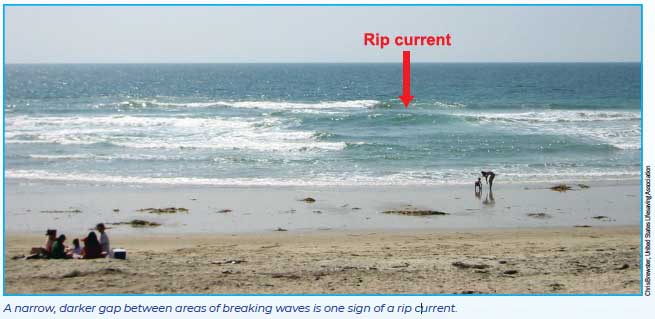
Rip currents account for more than 80% of rescues performed by surf beach lifeguards.

What are rip currents?
- Rip currents are channelized currents of water flowing away from shore at surf beaches.
- Rip currents typically form at breaks in sandbars, and also near structures such as jetties and piers.
- Rip currents are commonly found on all beaches, including Great Lakes beaches.
 Why are rip currents dangerous?
Why are rip currents dangerous?
- Rip currents pull people away from shore.
- Rip current speeds can vary from moment to moment and can quickly increase to become dangerous to anyone entering the surf.
- Rip currents can sweep even the strongest swimmer away from shore.
What are clues that a rip current may be present?
- A narrow gap of darker, seemingly calmer water between areas of breaking waves and whitewater.
- A difference in water color.
- A line of foam, seaweed or debris moving seaward.
What if I'm caught in a rip current?
-

Rip currents don’t pull you under
- Don’t swim against the current.
- You may be able to escape by swimming out of the current in a direction following the shoreline, or toward breaking waves, then at an angle toward the beach.
- You may be able to escape by floating or treading water if the current circulates back toward shore.
- If you feel you will be unable to reach shore, draw attention to yourself. If you need help, yell and wave for assistance
Facts about rip currents
- Rip current speeds vary. Average speeds are 1-2 feet per second, but they have been measured as fast as 8 feet per second – faster than an Olympic swimmer.
- Rip currents can be very narrow or more than 50 years wide.
- Sometimes a rip current ends just beyond the line of breaking waves; however, others may continue to flow hundreds of yards offshore.
- Rip currents do not pull people under from shore.
- Rip currents are sometimes mistakenly called undertow or riptides but these terms are not correct. Only the term rip currents is technically correct.
Safety tips
- Know how to swim
- Never swim alone.
- If in doubt, don't go out
- Swim near a lifeguard.
United States Lifesaving Association statistics indicate that the chance of death by drowning at a beach protected by lifeguards is 1 in 18 million.
How do I help someone else?
Don’t become a victim while trying to help someone else! Many people have died trying to rescue rip-current victims.
-
Get help from a lifeguard.
-
If a lifeguard is not present, call 9-1-1, then try to direct the victim to swim following the shoreline to escape.
-
If possible, throw the rip current victim something that floats.
-
Never enter the water without a flotation device.
Where can I get more information about rip currents?
- Before you leave for the beach, check the latest National Weather Service forecast for local beach conditions.
- When you arrive at the beach ask lifeguards about rip currents and other hazards.
- More information can be found at the following web sites
Weather - Rip Current
USLA (United States lifesaving Association)
NOAA's National Weather Service, National Sea Grant College Program, and the United States Lifesaving Association are working to educate the public on the dangers of rip currents.
